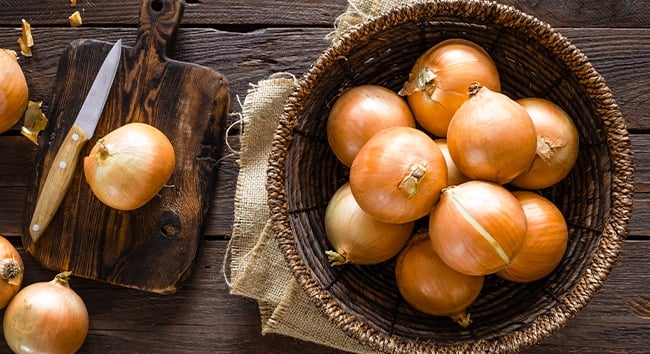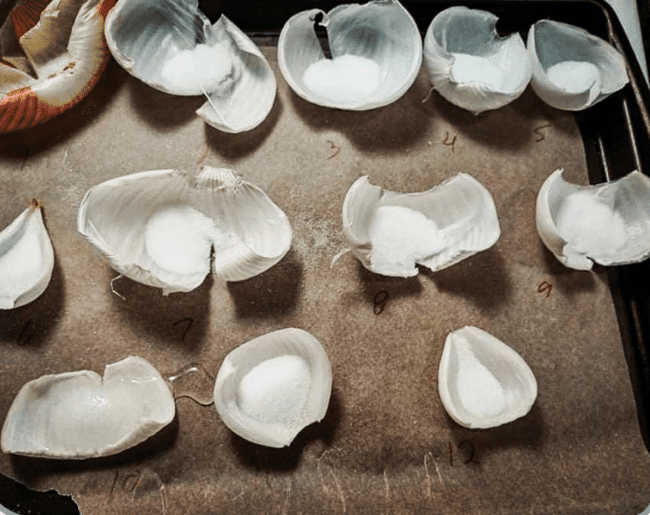How To Make An Onion Forecast (Onion Calendar)

Did you know you can make an onion forecast to predict the weather? An “Onion Calendar” It’s a time-honored folk weather forecasting technique used to predict levels of moisture for each month of the year ahead. All it takes is an onion, salt, a knife, and a little bit of patience! Learn more about this folklore and how to make one for yourself! Read on.
Donna and Delbert Eszlinger of Ashley, North Dakota, swear by this tradition and honor it each New Year’s Eve. In fact, The Ashley Tribune, reports on their onion calendar reading every year and it continues to be one of the most popular stories of the year.
Ashley is a tight knit German Russian Community located in the heart of southcentral North Dakota, steeped in tradition. For this Agrarian community, any kind of news or heads up in regard to anticipated moisture levels, is hopeful—especially within this string of dry years.
When asked about their famous onion calendar, Donna replies, “It’s a German tradition that’s been carried on from grandparents and great grandparents. That’s how they predicted the weather years ago and we kind of follow along with the old German traditions because we enjoy doing it, and because there was some truth to those things.”
Though, she stresses that the calendar doesn’t predict the weather as far as potential storms, hail, or blizzards. Rather it serves as an example of weather folklore used to determine the level of moisture throughout the calendar year.
How To Make An Onion Forecast (Onion Calendar)
According to the Eszlingers, you take a nice round, well-formed onion, cut it in half lengthwise, and peel apart the layers in each half. One side is indicative of the first six months of the year, and the other represents the last six months. (For example: The outermost onion layer represents January and July.)
Then put a teaspoon of salt in each of the cups between 11pm and 12am on New Year’s Eve. Let it set on a windowsill overnight.
On New Year’s morning there will be a certain amount of moisture in each of the onion cups. This indicates how much moisture will be in the atmosphere during each month of the year.

“If you’re getting moisture in the cups that represent March, April and May you will end up with snow,” Eszlinger said. “One year when we did it, January had a lot of moisture but July–which is the same piece of onion—had nothing.”
More Details
According to the Eszlingers, it doesn’t matter where the onion comes from, but other sources say the onion must be locally sourced. It’s also noted that this forecast only pertains to the area where the reading takes place.
The Eszlingers previous years had been pretty accurate, except for the year 2020. “The whole year was crazy. So what’s one onion?”
Find the most accurate weather forecasts here!
A Christmas Eve Version
An alternate method was documented in the November-December 1982 edition of Country People Magazine. Wilbur Hefti, a lifelong farmer and resident of rural Carroll Nebraska, shared a different approach to the calendar. His method was passed down for generations within his Swiss family and must take place on Christmas Eve, between 11pm and 12 am (because Christ was believed to be born within this window of time).
Hefti’s version calls for six large cooking onions as big as one’s fist. Each onion is cut in half lengthwise. The center core is popped out of each to form cups. Three-quarters of a teaspoon of salt (rather than a full teaspoon) is added within each half. Additionally, “Father, Son, and Holy Spirit” is uttered over each cup after the salt is added. Once all of the onions are salted, the sign of the cross is made over the lineup with a silent hand gesture. The onions then remain untouched until morning.
According to the article, Hefti claimed that his onion predictions were 60-80% accurate. He even recalled his father performing the ritual during the Christmas of 1935 during the peak of the depression. The onions were bone dry in the summer months, which was an accurate reflection of the weather that year.
Another Testimonial
Michael Moses of Wing, North Dakota, has used Hefti’s method for the past 38 years. He recalled his onions in 1987 and 1988 coming out dry. Those years were terrible drought years. This past March, he predicted “a good blizzard at the end of the month” which nearly rang true. His onion prediction might have been a couple weeks off, but a blizzard eventually came through the second week of April.
Join The Discussion!
Have you ever heard of an onion forecast (onion calendar) before?
Would you try to make one?
Do the instructions above make sense?
Let us know in the comments below!

Sabrina Hornung
Sabrina Hornung is a journalist and artist based in Lehr, North Dakota. She serves as editor-in-chief for the High Plains Reader, was the former editor for the Ashley Tribune/Wishek Star, and has contributed to the international folk art publication “Raw Vision.”



My grandmother did this every New Years Day, as did her parents before her. I have been carrying on the tradition since she passed in 2021.
So to make sure that I understand . . .
1. slice the onion
2. peel a layer from each onion, six from each side representing Jan – Jun and Jul – Dec
3. place salt on the inner part of the peeled onion
4. place on the window seal between 11 p.m. – next morning
5. dry layers mean little to no moisture for those layers and moisture for some to maybe a lot wetness for those months.
How do you determine. Which half is Jan-June and which half is July-Dec?
I’d love to see this re-posted in December – not sure I’ll remember by then. It would be neat to give it a try!
What do you do if your onion does not have enough layers ?
Be sure to use a big one! Some say even larger than a fist. Good luck!
My Iowa parents were dairy farmers up until this past year. They have been doing the Christmas version for 50 years. And the onions were 75 percent accurate for their area. My dad passed in April so I’ve been asked to take over the tradition for the family.
Wow! Thank you for sharing your family’s story. We are so glad to hear it was successful (and sorry to hear about your father’s passing). Be sure to come back and tell us how it goes. ?
I would really like to see a picture of the cut onions with the salt in them. Thank you.
Hi Bill, There is a photo in the story provided by the writer. If you look closely, you can see the salt in each of the onion layers.
It sounds like a fun activity to do with children. I might be game to try it for fun
Great, let us know how it turns out. Take pictures!